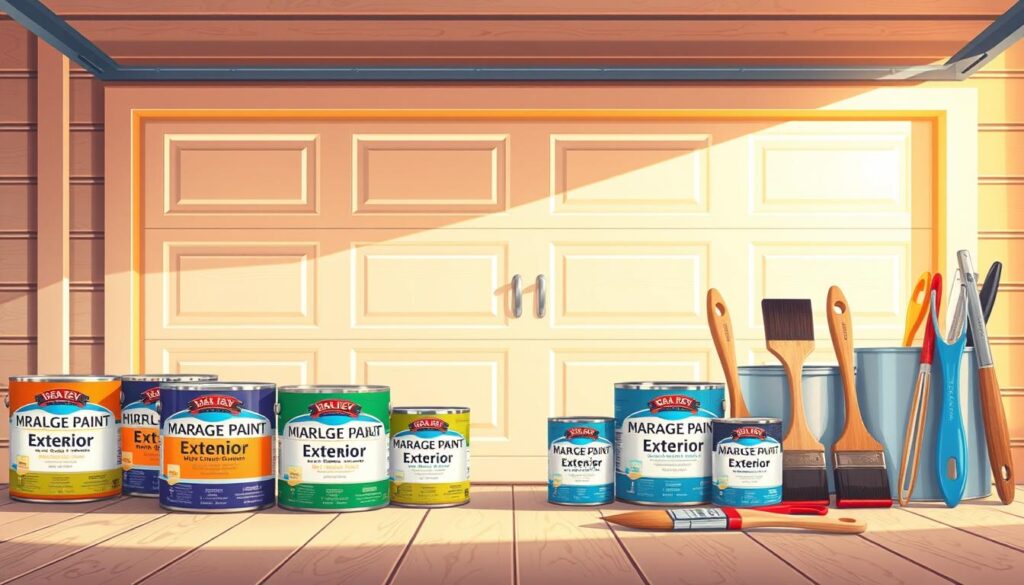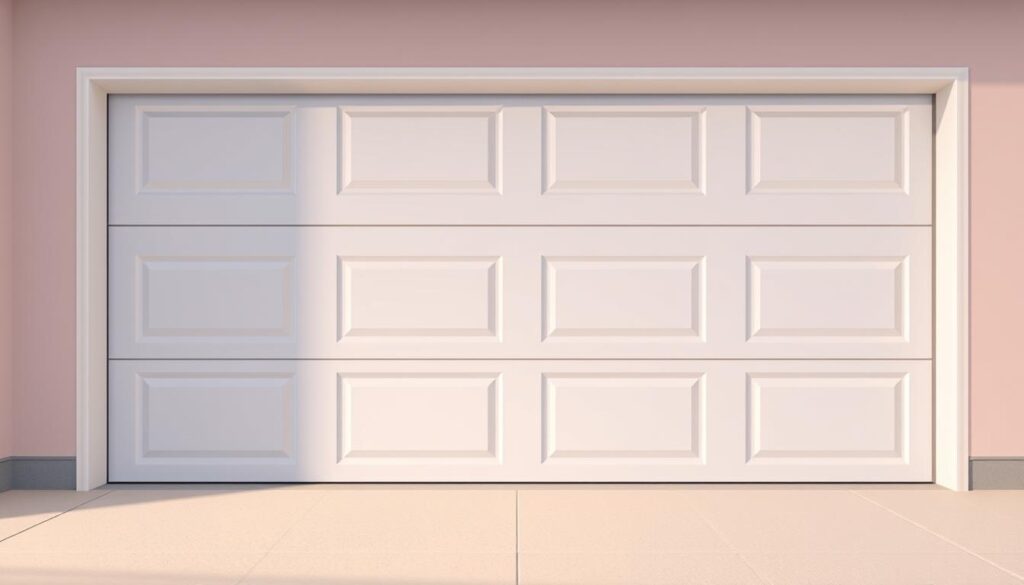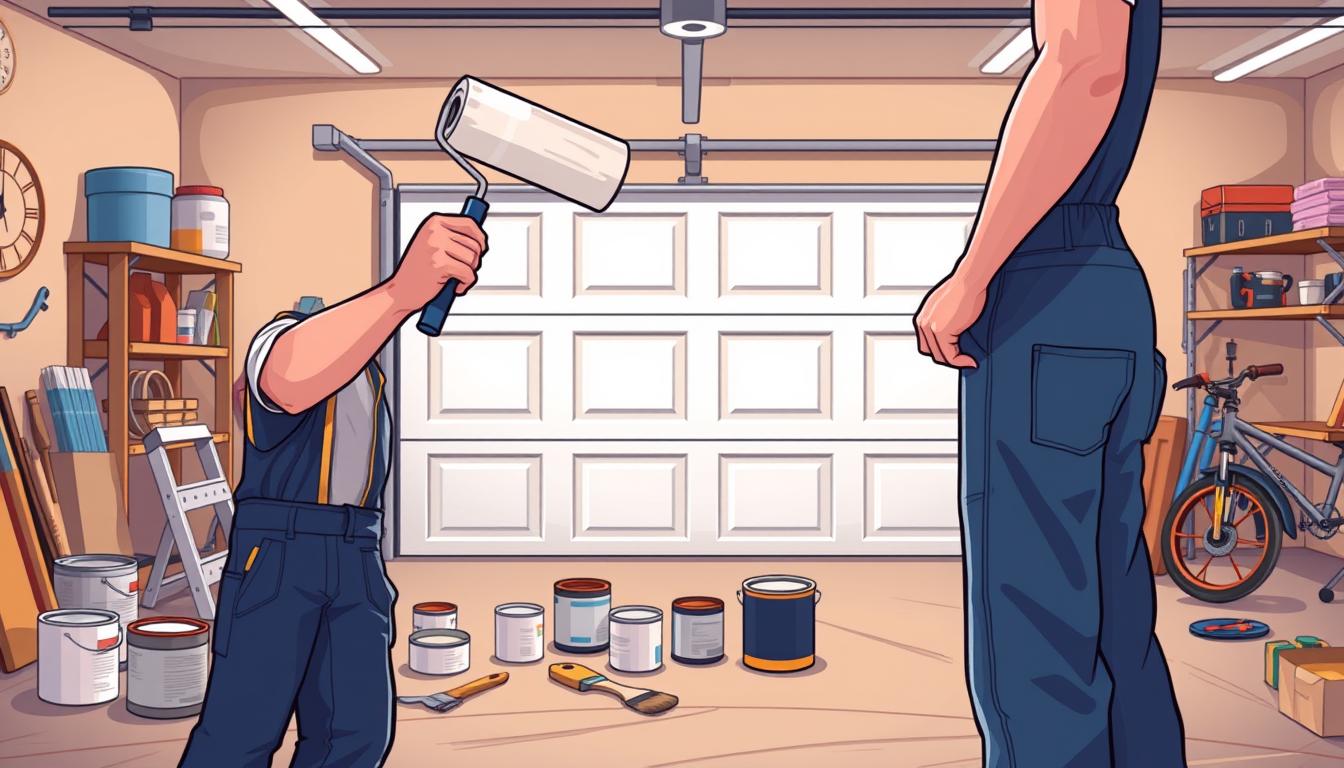Your garage door is the first thing people see. A fresh paint job can make your home look better. This guide shows you how to paint your garage door right, so it lasts a long time.
Painting your garage door is more than just picking a color. You need to prime it first. This makes the paint stick better. Use good paint to make it last longer.
Wait 12 hours before adding more coats. This stops the paint from peeling off. The weather should be calm and dry for the best results.
Keeping your garage door clean and doing touch-ups helps it last longer. With the right prep, your door can look new for up to 10 years. This guide will help you do it right, even if you’re new to painting.
Introduction to Painting Garage Doors
Your garage door is a key part of your home’s look. A new paint job can make it look fresh and protect it from the weather. Painting your garage door is more than upkeep. It’s a way to show off your style with garage door makeover ideas.
Importance of Painting Garage Doors
Painting keeps materials like wood or metal safe from sun, rain, and cold. If paint fades, the door can start to rot or rust. A new paint job can make your home look 20% better.
Benefits of a Fresh Coat of Paint
- Protection: Paint keeps the door safe from the outside world.
- Cost Efficiency: Doing it yourself saves money, way less than a new door.
- Style Flexibility: Pick colors that match your home. Bright colors can make your home seem 10-15% more valuable.
Tools like the Wagner FLEXiO 5000 HVLP sprayer make painting faster. It cuts down on waste by 30%. Whether you want a classic or modern look, painting your garage door is smart. Make sure to prepare well for the weather and the material. This way, your garage door will stand out.
Tools and Materials Needed
Starting a DIY garage door painting project needs the right tools. Each item on this list helps get a lasting, professional look.
Essential Painting Tools
- 2–2.5” angle-cut brush for edges and corners
- 3/4” roller with a 9/16” nap for even paint distribution
- Drop cloths to protect surrounding surfaces
- Painter’s tape for masking trim and hardware
- Wire brush and sandpaper (50–100 grit) for surface prep

Recommended Paint Types
Choose the best paint for garage doors based on your door type. Wood doors need latex-based exterior paint. Metal doors do best with oil-based paint.
“Satin enamel strikes the perfect balance between durability and ease of cleaning,” says the EPA’s guide on exterior coatings.
Clark and Kensington Exterior Paint and Primer is a good choice. Apply primer first. Let it dry 12–24 hours before painting.
Safety Gear Considerations
Wear safety goggles, rubber gloves, and a dust mask. If your home was built before 1978, test for lead paint first. Always paint in temperatures above 50°F and low humidity. Avoid painting in direct sunlight or extreme heat.
Preparing the Garage Door for Painting
Getting your garage door ready for paint is key. It makes the job last longer and look better. Cleaning and fixing any damage are the first steps.
Cleaning the Surface
Begin by making the surface clean. Use a hose with a spray nozzle to remove dirt. For tough spots, mix a little soap with water and gently scrub.
Don’t use power washing too close. Keep the nozzle 18 inches away to avoid chipping the paint. Let the door dry fully before painting.

Repairing Damages
- Scrape away loose paint with a putty knife.
- Fill cracks or dents with exterior-grade filler, then sand smooth once dry.
- Rust needs extra care: brush it off, apply rust-inhibiting primer, and sand lightly.
Tip:Use 120-grit sandpaper to smooth repaired areas before priming.
Weather Conditions
Paint when the weather is just right. Look for days with temperatures between 50°F and 85°F. Stay away from high humidity and wind.
Experts at Hunter Door say, “Paint on warm, dry days for even drying and better sticking.”
“A garage door can constitute up to 50% of a home’s street-facing appearance. Proper prep guarantees that investment lasts.” — Hunter Door Team
Wait 24 hours after cleaning before painting. If it’s hot, paint in the evening. This helps avoid quick drying that causes brush marks.
Painting Techniques for Garage Doors
Learning the right painting techniques for garage doors gives you a pro look. It stops peeling and fading. You can do it yourself, just like professional garage door painting services. First, pick the right tools for your door.
Brush vs. Roller vs. Sprayer
Choose tools based on surface texture and door design:
- Brushes: Use 3-inch flat sash brushes for edges and corners. A 2-2.5-inch angled brush cuts in around hardware and seams.
- Rollers: Pair 9-inch rollers with 3/16-inch nap for smooth surfaces or 1/2-inch nap for textured panels. Apply paint in W-patterns to ensure even coverage.
- Sprayers: Ideal for large metal or vinyl doors. Mask all non-painted areas, and keep the sprayer 12-18 inches from the surface to avoid drips.
Techniques for Even Application
Paint in sections to avoid lap marks. For panel doors, brush edges first, then fill with a roller. On flat doors, start at the top and work down. Wait 12 hours between coats—two thin layers outperform one thick coat. Paint the visible upper edge when the door is open to avoid missed spots. Use latex or acrylic exterior paint; metal doors require direct-to-metal primer first. Always paint in 50-75°F weather with low humidity to ensure proper drying.
Finishing Touches and Sealing
Finishing your painting project right makes your painting exterior garage doors last long. A good seal keeps out weather and looks great. Follow these step-by-step garage door painting final steps for lasting results.
Applying a Second Coat
Wait 12–24 hours for the first coat to dry. Then, apply a second coat the same way. Look for uneven spots in sunlight before you start.
Use thin, even strokes to avoid drips. Remove painter’s tape while the paint is a bit wet. This helps prevent peeling edges.
- Wait 12–24 hours between coats to avoid smearing.
- Start at the top and work down to blend strokes smoothly.
- Inspect in natural light to spot missed spots and touch up immediately.
How to Properly Seal the Paint
Sealing keeps the color bright and prevents fading. Use a clear acrylic topcoat for wood or a UV-resistant sealant for metal. Apply with a brush or roller in the same direction as the first coat.
Let the final coat dry fully—24–48 hours—before using the door. Don’t touch or lean on wet paint. For extra protection, apply ScotchBlue™ Painter’s Tape only after 30 days on new surfaces to prevent lifting. Check and touch up every 5–7 years to keep it looking good.
Being patient here means your garage door will look new for years. Proper sealing and drying times are key to avoid mistakes.
Maintenance Tips for Painted Garage Doors
Follow garage door painting tips to keep your DIY project looking great for years. Regular care stops early wear and keeps your home’s look sharp. Here’s how to make your painted door last longer.
Regular Cleaning Practices
Steel garage doors, like those from Wayne Dalton, need little care but annual cleaning. Mix one cup of mild detergent (less than 0.5% phosphate) in five gallons of warm water. Don’t use harsh scrubbers—use a soft sponge to avoid scratches.
For wax buildup, gently wipe with a gray 3M ScotchBrite pad. Rinse well and dry right away, if you live near the coast. Salt can harm the paint.
Touch-Up Tips for Longevity
Keep leftover paint in a sealed container for small chips. When touching up, blend edges into the old paint to hide lines. Lightly sand scratches with 0000 steel wool before applying primer and new paint.
Exposed metal must be primed to stop rust. Always use top-quality latex paint, not oil-based, to match the factory finish.
When to Repaint or Refresh
Most painted garage doors need repainting every 5–7 years, based on weather and sun. Look for signs like chalking, fading, or peeling to know it’s time. Factory-finished Wayne Dalton doors may last longer, but regular care helps.
If you’re unsure about prep or painting, get help from a pro. Hunter Door’s 45 years of experience says do the work when it’s 50–85°F outside for the best results.

